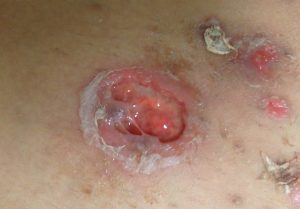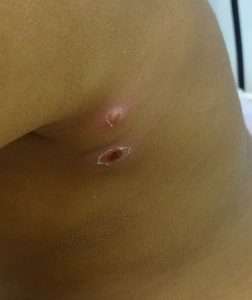Chapter 6: Infections and Infestations
Bacterial Infections: Other Skin Conditions Caused by S. Aureus and S. Pyogenes
In addition to cellulitis and impetigo, S. aureus and S. pyogenes can cause a variety of other skin conditions. Which skin manifestation is seen generally depends on the depth at which bacterial infection occurs, or – in the case of staphylococcal scalded skin syndrome – if a toxin is present in the blood.
Erysipelas is a bacterial infection typically caused by S. pyogenes. It affects lymphatics within the dermis (i.e. deeper than the level of impetigo but more superficial than cellulitis). It is typically seen on the face or lower extremity. It presents as a very well defined, bright red, tender plaque.
Ecthyma is a deeper form of impetigo caused by S. pyogenes. It often starts superficially but extends into the deeper layers of the skin and can result in ulceration and scarring. It commonly begins as small fluid-filled vesicles, often seen on the lower extremities and buttocks, which rupture and form shallow crusted ulcers.

Furuncles (“boils”) and abscesses are walled-off collections of pus, usually caused by S. aureus. Whereas an abscess can occur anywhere in the body, a furuncle is, by definition, associated with a hair follicle. They are most commonly seen on the neck, axilla, and buttock but may appear anywhere. Most furuncles eventually come to the surface and rupture. For early/small furuncles, treatment with warm compresses and oral antibiotics may be sufficient. If lesions appear deep and may not rupture spontaneously, incision with drainage and packing with iodoform or Vaseline gauze are required for clearance. Without the packing, the wound can heal from the top leaving an empty space inside that can become re-infected.

Necrotizing Fasciitis is a deep infection involving the fascia located beneath the subcutaneous tissue. This is a life-threatening condition, and the extent of disease is often not evident from the findings seen on the skin. S. pyogenes is the most common cause, and infection usually enters the skin through a site of injury, although this may not always be the case. It often resembles cellulitis initially, however, rapid progression and pain out of proportion to skin findings are hallmark findings. If suspected, patients should be urgently seen in a tertiary centre for antibiotic and surgical treatment.
Staphylococcal scalded skin syndrome is a blistering skin condition most often seen in children under 5 years old. It is caused by toxins released by S. aureus. Although there is often a localized focus of infection such as the nasopharynx or conjunctivae, the areas of blistering are generally sterile. The rash often starts as redness around the mouth and within the skin folds. Flaccid, easily ruptured blisters develop. The skin around the mouth may develop characteristic “radial fissures”. Skin tenderness, fever and irritability are often present. Patients generally require hospitalization for supportive care as well as to receive IV antibiotics covering S. aureus. Tape should be avoided as the skin will often peel off when the tape is removed.
Hover over image for caption.

